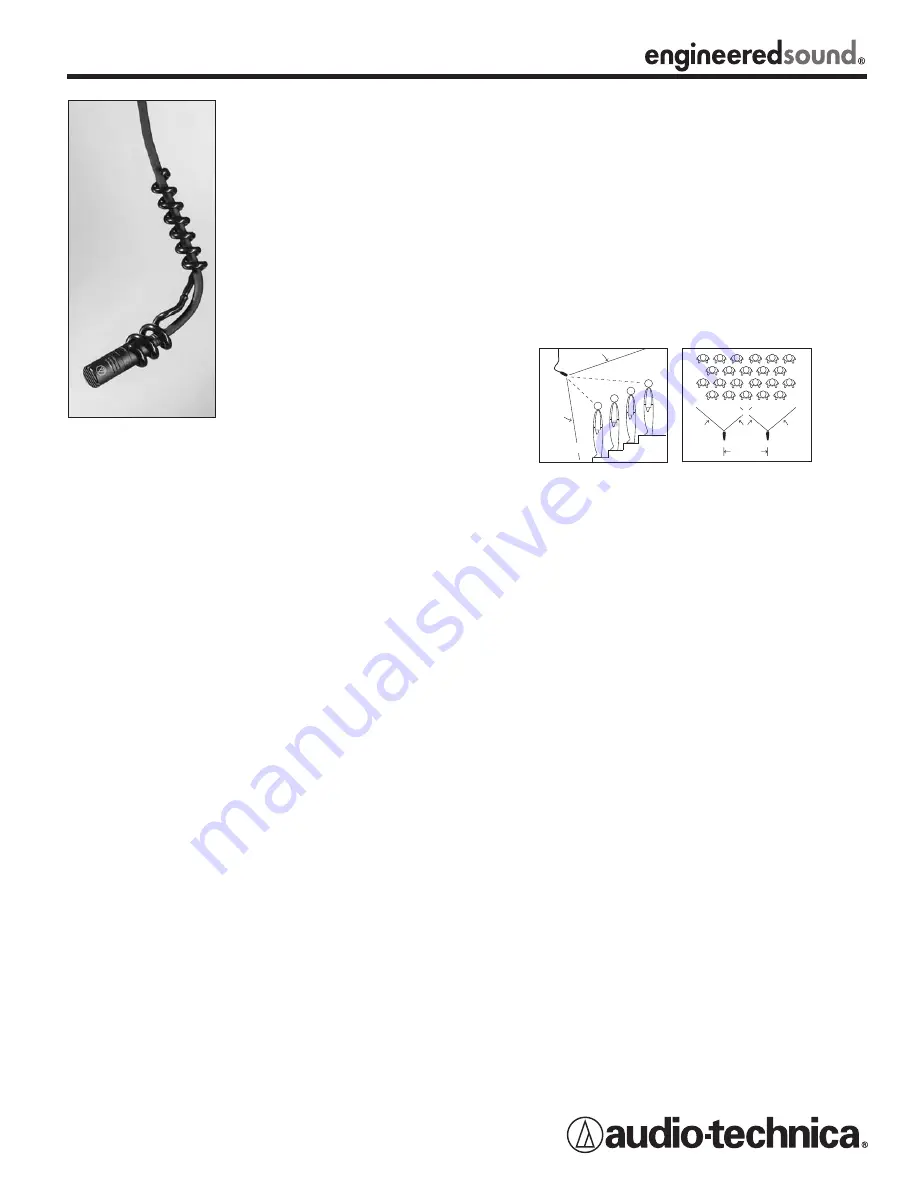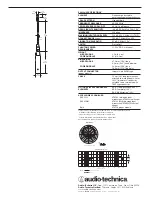
DESCRIPTION
The ES933H is a wide-range miniature
condenser microphone with a hyper-
cardioid polar pattern. It is designed
for quality sound reinforcement,
professional recording, television
and other demanding sound pickup
applications. The ES933H is furnished
with a vinyl-coated steel hanger that
allows it to be adjusted for correct
positioning. An included snap-on foam
windscreen effectively reduces noise
from wind or ventilation air currents.
The ES933H is equipped with
UniGuard
®
RFI-shielding technology,
which offers outstanding rejection of
radio frequency interference (RFI).
The microphone is RoHS compliant –
free from all substances specified in
the EU directive on hazardous
substances.
The microphone's hypercardioid polar
patter n provides a 100° angle of
acceptance. Additional interchangeable elements with omnidirec-
tional (360°), cardioid (120°) and MicroLine
®
(90°) pickup patterns
are available.
The microphone features a 50' (15.2 m) permanently attached
miniature cable. Its free end connects to the provided AT8538
power module via TA3F-type connector. It can be powered from
any external 11V to 52V DC phantom power supply. A recessed
switch in the power module permits choice of flat response or low-
frequency roll-off (via integral 80 Hz high-pass UniSteep
®
filter) to
help control undesired ambient noise.
The microphone is enclosed in a rugged housing with a low-
reflectance black finish. It is also available with white housing,
cable and hanger as the ES933WH. The AT8538 power module is
finished in black.
INSTALLATION AND OPERATION
The ES933H requires 11V to 52V phantom power for operation.
The combination of small size and excellent response makes the
ES933H ideal for suspension over choirs, instrumental groups
or theater stages. A uniform 100° angle of acceptance provides
well-balanced audio pickup. The microphone should be located
forward of the front-most source, above the rear-most source, and
“aimed” between them (Fig. 1). Increasing the height of the mic
above the sources will tend to equalize sound levels between
them, but may also increase pickup of background or reverberant
sound. Whenever possible, the distance from the mic to the rear-
most source should be no more than twice the distance to the front
source, to maintain front-to-rear balance (Fig. 1).
Width of pickup is approximately 2.5 times the distance to the
closest performer. If additional mics are needed for wide sources,
they should be positioned apart laterally at least 2.5 times the
distance to the front source, to avoid phase cancellation (Fig. 2).
To orient the microphone in the proper direction, twist the housing
slightly in its wire holder (clockwise rotation moves the microphone
to the right; counterclockwise rotation moves it to the left).
The provided foam windscreen simply snaps over the head of the
microphone, effectively reducing noise from wind or ventilation air
currents.
Output is low impedance balanced. The output connector of the
power module mates with XLRF-type cable connectors. The
balanced signal appears across Pins 2 and 3, while the ground
(shield) connection is Pin 1. Output is phased so that positive
acoustic pressure produces positive voltage at Pin 2, in
accordance with industry convention.
An integral 80 Hz high-pass UniSteep
®
filter provides easy
switching from a flat frequency response to a low-end roll-off. The
roll-off position reduces the pickup of low-frequency ambient noise
(such as traffic, air-handling systems, etc.), room reverberation and
ES933H
HYPERCARDIOID CONDENSER
HANGING MICROPHONE
mechanically coupled vibrations. To engage the UniSteep
®
filter, use the end tip of a paperclip or other small pointed
instrument to slide the switch toward the “bent” line.
While a modern condenser microphone is not unduly sensitive
to the environment, temperature extremes can be harmful.
Avoid leaving the microphone in the open sun or in areas where
temperatures exceed 110° F (43° C) for long periods of time.
Extremely high humidity should also be avoided.
NOTE:
Audio-Technica has developed a special RFI-shielding
mechanism that is an integral part of the connectors in the
Engineered Sound line. If you remove or incorrectly replace the
connector, you may adversely affect the unit's RFI immunity.
Audio-Technica offers a crimp tool (ATCT) and RFI shields for
TA3F-type, TA5F-type and XLRM-type connectors that enable you
to shorten the cable and correctly reinstall the connector while
maintaining the highest level of RFI immunity.
ARCHITECTS AND ENGINEERS SPECIFICATIONS
The microphone shall be a fixed-charge condenser designed for
suspended installation in permanent or portable applications.
It shall have a frequency response of 80 Hz to 20,000 Hz and
a hypercardioid polar pattern with uniform 100° angle of accep-
tance. It shall be capable of accepting optional interchangeable
elements for additional polar patterns. It shall be capable of
handling sound input levels up to 138 dB with a dynamic range of
109 dB. Nominal open-circuit output voltage shall be 10.0 mV at
1 kHz, 1 Pascal. Output shall be low impedance balanced (250 ohms).
The microphone shall operate from an external 11V to 52V DC
phantom power source. It shall offer outstanding rejection of radio
frequency interference (RFI). The microphone shall be RoHS compliant.
The microphone shall have a permanently attached 50' (15.2 m)
miniature low-noise cable. Its free end shall connect to a provided
power module via TA3F-type connector. An optional crimping tool
and crimp sleeves shall allow for shortening of the cable without
loss of RFI immunity. The power module shall include a recessed
switch for low-frequency roll-off. The low-frequency roll-off shall be
a tailored roll-off at 80 Hz to minimize pickup of unwanted
mechanical noise. Output from the power module shall terminate
in a 3-pin XLRM-type output connector.
For suspended installations, the microphone shall be provided
with an adjustable steel wire hanger. The steel wire hanger shall
attach to the microphone body and allow for the positioning of the
microphone without the need for tools. Microphones using
goosenecks or other methods for positioning shall be unacceptable.
A snap-on foam windscreen shall be provided.
The microphone shall be 1.08" (27.5 mm) long with a head diameter
of 0.33" (8.4 mm). The microphone weight shall be 0.2 oz
(5.5 grams) without cable. The microphone case, cable and steel
hanger shall be finished in black [white]. The power module shall
be finished in black.
The Audio-Technica ES933H [ES933WH] is specified.
LESS THAN 2 TIMES “X”
DIST
ANCE “X”
100
°
ANGLE OF
ACCEPTANCE
Figure 1
MIC A
2.5 TIMES
DISTANCE “X”
MIC B
100
°
100
°
Figure 2




















